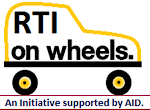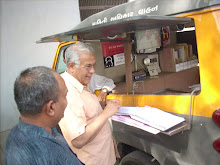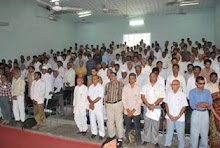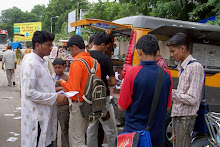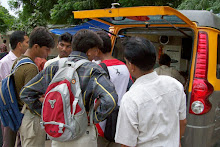Outlook: Gujarat: Wednesday, August 01, 2012.
The Congress in Gujarat seems to have taken a leaf out of the army training manual which exhorts one to “sweat in peace to bleed less in war”. Relentlessly pounded by a Narendra Modi-led BJP in two assembly elections, in 2002 and 2007, the Congress is working determinedly to change the picture now. With the Modi government completing its present term on January 17, 2013, the 3.69 crore registered voters should be casting their votes sometime in December 2012 to elect a new government.
Two factors have played a key role in awakening the long-comatose Congress. One, the local leadership has realised that having been out of power in the state for almost a quarter century now, the party stands pushed to the very margins. The national leadership, which has been culpable in equal measure, now has to contend with the spectre of the subedar of Gujarat setting his sights on the throne of Delhi. The threat, even if notional, has national implications. (Modi’s interview this week to an Urdu weekly see excerpts was a clear attempt to set straight the record on the 2002 riots and project himself as not being anti-Muslim.)
To that end, the Congress drew up a battle plan at least a year ahead of the polls. “Our answer to the Gujarat CM’s three-day sadbhavana fast was the turning point of our will to take on the BJP government in Gujarat,” says Shankersinh Vaghela, chairman of the state Congress poll campaign committee.
In his almost 11-year-long rule, the Congress has been no match for Modi’s political wiles. He has crafted success out of calamities, manmade or natural, be it the Godhra carnage and the ensuing riots in 2002 or the Surat floods in 2006. On the back of his state-wide yatra before the 2002 state elections, the BJP bagged 126 seats, leaving the Congress with 51 and independents with four in a total of 182 seats. The Congress improved its tally by 11 in 2007, but the BJP retained a majority with 117. Now to 2012.
“We are much better prepared and more systematic in our approach,” says Gujarat Congress spokesperson Manish Doshi. “Armchair engineering has been replaced by field functioning. The state has been properly mapped in terms of demographic spread, caste and community demarcation, rural and urban divisions, an understanding as well as analysis of our own strengths and weaknesses as well as those of the adversary.”
Indeed, realising its low support in urban areas, a fortnight-long series of agitational programmes got under way from July 1 to 15 in eight municipal corporation areas, covering 40 Vidhan Sabha constituencies. Earlier in April, another fortnight-long ‘parivartan yatra’ had covered four municipal corporations and 159 municipalities through 180 meetings. On July 9, a ‘kinara bachao’ campaign rally was launched, to cover the coastal areas. Vaghela is also upbeat after the Kshatriya sammelan at Patan drew good response as did the Patidar sammelan in Mehsana, both towns in north Gujarat considered to be a Modi bastion.
Normally laggards in the use of technology and beaten by the BJP by a mile, the Congress now has dedicated teams for its “cyber warfare”. The SMS battle has been joined similarly, a taste of which Modi got ahead of the Brahmin sammelan at Surat on April 24: “RSS aur BJP mein Damleji, Sanjay Joshi, Hemant Shukla, Ashok Bhatt, Nalin Bhatt, Haren Pandya jaise kayi Brahmin neta the, lekin aaj koi nahin hai. Itne dinon tak brahminon ko door rakhne ke baad, Modi ab kyon unke paas aa rahe hain?”
Shaktisinh Gohil, leader of the Congress legislature party, attributes the Congress win in the Mansa Vidhan Sabha byelection on March 21 to this all-hands-in-the-field approach. “This seat that we snatched back after 17 years has done wonders for the morale of the party workers. It’s the wages of labour and unity.”
A major thrust of the Congress campaign is on highlighting the sins of omission and commission of the Modi government. These include the CAG report, the Lokayukta verdict, the high court indictments as well as emotive issues involving missing children or the case where 23 children became HIV positive owing to blood transfusion at a government hospital.
The Congress is also targeting the misdemeanours of Modi’s ministers and key legislators. Fisheries minister Purshottam Solanki, for instance, has been indicted by the high court in a Rs 400-crore fisheries contract scam but the Modi cabinet has turned down permission to prosecute him. Dilip Sanghani, the agriculture minister, is also under a cloud, with the court ordering him to be named in a complaint of assault on an RTI activist. BJP legislator Shanker Chaudhary has been indicted for irregularities in claiming earthquake relief from the PM’s fund. The mud is sticking, says Gujarat Congress chief Arjun Modvadia. He, along with Vaghela and Gohil, released a 12-point agenda on July 24. Termed the ‘Gujarat People’s Development Vision-2012’, it’s a list of 12 promises it seeks to implement if voted to power.
This is the first time the Congress is making its political intentions clear almost six months ahead of its rivals. By contrast, Modi so far has just made a five-day visit to Japan at the head of a high-level corporate delegation, seeking to garner support for the global investors’ summit in January. Most people expect him to be still in power then. Will the Congress’s exertions be enough to prove them wrong?




